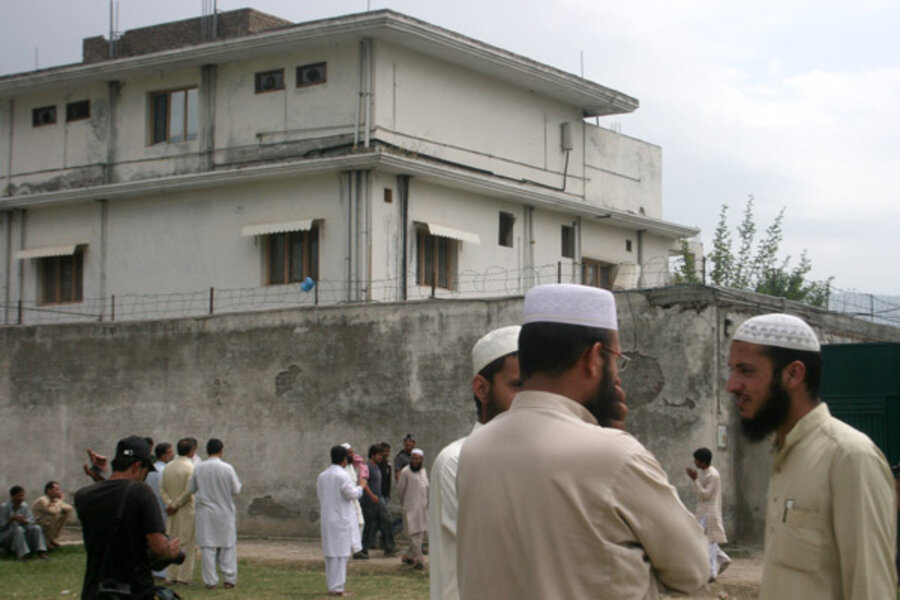Did harsh interrogation tactics help US find Osama bin Laden?
Loading...
How did the US intelligence community get the information that led American commandos Sunday night to Osama bin Laden’s walled compound in Abbottabad, Pakistan?
The question is at the core of a rekindled debate over the value of harsh interrogation tactics authorized under President George W. Bush.
Claiming vindication, former Bush officials say the information gleaned years ago from the harsh techniques bore fruit. But members of the Obama administration are downplaying its importance, pointing instead to patient analysis.
“There is no single piece of information, beyond the location of the compound where Osama Bin Laden was hiding out, that was incontrovertibly critical to the success of this operation,” White House Spokesman Jay Carney said on Wednesday.
Given the murky and subjective nature of intelligence gathering and analysis, however, it is a debate that is unlikely to end with a definitive resolution.
The first bit of information that eventually led US commandos to bin Laden on Sunday was the nom de guerre of an Al Qaeda courier – “Abu Ahmed al-Kuwaiti.”
Mr. Kuwaiti’s real name is Sheikh Abu Ahmed. He died Sunday trying to protect bin Laden during the commando raid.
Officials say it took years after the initial mention of Kuwaiti during a detainee interrogation for US intelligence officers to identify him, locate him, track his communications, and then follow him to the unusually large and well fortified compound in Abbottabad.
The key question in the debate is whether the use of harsh interrogation techniques – including waterboarding – helped hasten the identification of Kuwaiti, and eventually the operation against bin Laden.
Obama administration officials say it was patient and detailed intelligence analysis, not statements blurted out during waterboarding, that led to the successful raid.
“We have multiple ways of gathering information, from detainees, from different methods,” Mr. Carney said. “The work that was done that put the case together was done primarily by analysts gathering tiny bits of information and putting it together and creating a body of work that led to [bin Laden],” he said.
John Brennan, assistant to the president for homeland security, has said information obtained through waterboarding did not, to his knowledge, play a role in the operation.
On Tuesday Brennan told reporters “counterterrorism work … is exceptionally tedious and painstaking as far as taking a little bit of data and piecing it together and trying to correlate it with something else.”
Others say the Bush administration’s aggressive approach to intelligence gathering in the wake of the 9/11 attacks created the massive pool of data that eventually allowed intelligence analysts to put together pieces of a puzzle that led to bin Laden.
“President George W. Bush, not his successor, constructed the interrogation and warrantless surveillance programs that produce this week’s actionable intelligence,” wrote former Justice Department legal adviser John Yoo in a Wall Street Journal op-ed piece.
“According to current and former administration officials, CIA interrogators gathered the initial information that ultimately led to bin Laden’s death,” Mr. Yoo said.
In an interview with Time magazine, the former director of the CIA’s counterterrorism center, Jose Rodriguez, said the first important leads about Kuwaiti came from alleged 9/11 mastermind Khalid Sheikh Mohammed (KSM) and Abu Farraj al-Libbi, the third-ranking Al Qaeda leader at the time of his capture. Both men were interrogated at secret CIA “black sites,” where Mr. Mohammed was subject to waterboarding 183 times.
“Information provided by KSM and [Mr. Libbi] about bin Laden’s courier was the lead information that eventually led to the location of the compound and the operation that led to his death,” Mr. Rodriguez is quoted as saying.
Former Defense Secretary Donald Rumsfeld told Fox News’s Sean Hannity that the Obama administration would not have had “the kinds of intelligence that was critically important,” but for the aggressive efforts of the Bush administration.
“Anyone who suggests that the enhanced techniques, let’s be blunt – waterboarding – did not produce an enormous amount of valuable intelligence just isn’t facing the truth,” he said.
Attorney General Eric Holder was asked during a House Judiciary subcommittee hearing on Tuesday whether any intelligence information that led to the bin Laden mission was the result of enhanced interrogation techniques.
“There was a mosaic of sources that led to the identification of the people who led to [bin Laden],” the attorney general said.
“I understand that,” replied Rep. Dan Lungren (R) of California. “But were any pieces of that mosaic the result of enhanced interrogation techniques?”
Attorney General Holder: “I do not know.”





